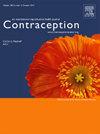Not here, not now: a mystery caller study of availability of mifepristone in community pharmacies in Alberta, Canada
IF 2.3
2区 医学
Q1 OBSTETRICS & GYNECOLOGY
引用次数: 0
Abstract
Objectives
This study assessed same-day availability, dispensing practices, and information provision for mifepristone in Alberta pharmacies.
Study design
Cross-sectional data from 1620 pharmacies (>99% response) were collected from pharmacy respondents using a mystery caller approach (January to October 2024). Using a standardized script, team members inquired about mifepristone availability, Alberta’s coverage plan, and dispensing. Outcomes included (1) same-day stock availability, (2) willingness to order, (3) refusal to order, and (4) conscientious objection. Accuracy of cost information and adherence to regulatory standards were assessed. Geographic patterns and associations with the deprivation index of pharmacy location were explored.
Results
Same-day dispensing was available at 12.9% pharmacies, and 76.2% offered to order it, with delivery times estimated from the next day to 10 days. A small number of pharmacies (n = 86, 5.3%) did not offer to order with no reason given; conscientious objection was reported by 90 pharmacies (5.6%), of which only 10.0% (n = 9) provided onward referrals. Awareness of Alberta’s universal coverage for mifepristone was low; 71.1% of respondents incorrectly stated that uninsured patients must pay out of pocket. Mifepristone was less often in stock in Alberta’s two major cities; pharmacies in high-deprivation areas were less likely to have mifepristone in stock and more often expressed conscientious objection.
Conclusion
Same-day mifepristone availability in Alberta pharmacies is limited, and adherence to referral standards among objectors is poor. Awareness of universal coverage is suboptimal, raising concern about overcharging. Enhancing access may require collaboration between abortion providers and pharmacies, increased communication about coverage policies, and innovative solutions related to dispensing.
Implications
Limited same-day access to mifepristone, compounded by poor adherence to regulatory standards and low awareness of public coverage, highlights equity gaps in abortion care across Alberta, Canada. Targeted policy reforms and pharmacist education are needed to improve timely, reliable access, particularly for socioeconomically disadvantaged communities.
不是在这里,不是现在:加拿大阿尔伯塔省社区药房米非司酮可用性的神秘来电者研究。
目的:本研究评估当天可用性,配药做法,并提供信息的米非司酮在艾伯塔省药房。研究设计:采用神秘来电法从药房受访者中收集1620家药店的横断面数据(bbbb99%的回答率)(2024年1月至10月)。使用标准化的脚本,团队成员询问米非司酮的可用性,艾伯塔省的覆盖计划和分配。结果包括:(i)当日库存可用性,(ii)订购意愿,(iii)拒绝订购(iv)良心反对。评估了成本信息的准确性和对监管标准的遵守情况。探讨了药学区位的地理格局及其与剥夺指数的关系。结果:12.9%的药店可当日配药,76.2%的药店可订购当日配药,预计配送时间为次日~ 10天。少数药店(n=86, 5.3%)无理由不下单;90家药店(5.6%)报告了良心拒服兵役,其中只有10.0% (n=9)提供了后续转诊。对艾伯塔省米非司酮普遍覆盖的认识很低;71.1%的受访者错误地认为没有保险的患者必须自掏腰包。在艾伯塔省的两个主要城市,米非司酮的库存较少;在高剥夺地区的药店不太可能有米非司酮库存,更经常表示出于良心反对。结论:当天米非司酮在艾伯塔省药房的可用性是有限的,并且反对者对转诊标准的依从性很差。全民医保的意识不够理想,引发了对收费过高的担忧。加强可及性可能需要堕胎提供者和药房之间的合作,就覆盖政策加强沟通,以及与配药有关的创新解决方案。影响:当天获得米非司酮的机会有限,加上对监管标准的遵守不力和对公共覆盖的认识不足,突显了加拿大阿尔伯塔省堕胎护理的公平差距。需要有针对性的政策改革和药剂师教育,以改善及时、可靠的获取途径,特别是对社会经济上处于不利地位的社区。
本文章由计算机程序翻译,如有差异,请以英文原文为准。
求助全文
约1分钟内获得全文
求助全文
来源期刊

Contraception
医学-妇产科学
CiteScore
4.70
自引率
17.20%
发文量
211
审稿时长
69 days
期刊介绍:
Contraception has an open access mirror journal Contraception: X, sharing the same aims and scope, editorial team, submission system and rigorous peer review.
The journal Contraception wishes to advance reproductive health through the rapid publication of the best and most interesting new scholarship regarding contraception and related fields such as abortion. The journal welcomes manuscripts from investigators working in the laboratory, clinical and social sciences, as well as public health and health professions education.
 求助内容:
求助内容: 应助结果提醒方式:
应助结果提醒方式:


